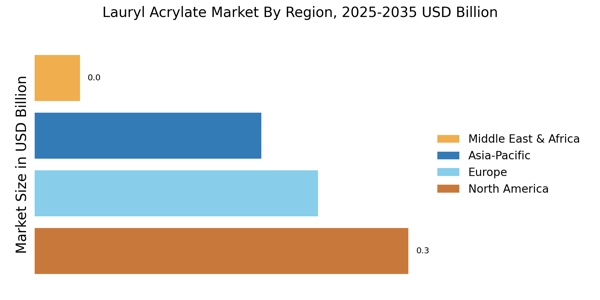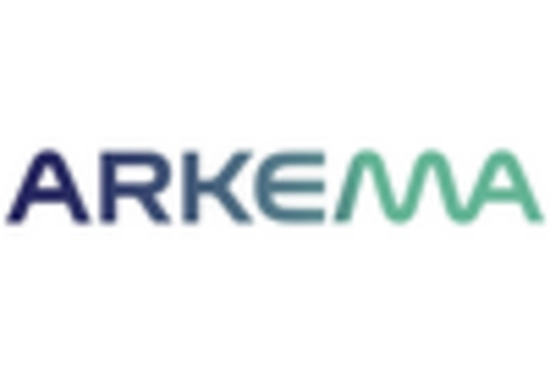Growth in Coatings and Paints Sector
The Lauryl Acrylate Market is significantly influenced by the growth in the coatings and paints sector. With an increasing emphasis on aesthetic appeal and durability, lauryl acrylate is being incorporated into various formulations to enhance performance characteristics. The coatings market is expected to witness a growth rate of around 4.8% annually, driven by rising consumer preferences for high-quality finishes. Lauryl acrylate contributes to improved gloss, adhesion, and weather resistance in coatings, making it a preferred choice among manufacturers. This trend indicates a robust future for lauryl acrylate as it aligns with the industry's shift towards innovative and high-performance coating solutions.
Expansion of the Personal Care Industry
The Lauryl Acrylate Market is also benefiting from the expansion of the personal care sector. As consumer awareness regarding personal grooming and hygiene increases, the demand for high-quality personal care products is on the rise. Lauryl acrylate is utilized in formulations for hair care, skin care, and cosmetics due to its emulsifying and thickening properties. Market analysis suggests that the personal care industry is projected to grow at a rate of approximately 5.5% over the next few years, which could lead to increased utilization of lauryl acrylate in various formulations. This growth presents opportunities for manufacturers to innovate and develop new products that cater to evolving consumer preferences.
Rising Demand in Adhesives and Sealants
The Lauryl Acrylate Market is experiencing a notable surge in demand for adhesives and sealants, primarily driven by the construction and automotive sectors. As these industries expand, the need for high-performance bonding solutions becomes increasingly critical. Lauryl acrylate, known for its excellent adhesion properties and flexibility, is being utilized in various applications, including construction adhesives and automotive sealants. Market data indicates that the adhesives segment is projected to grow at a compound annual growth rate of approximately 5.2% over the next five years, further solidifying the position of lauryl acrylate in these applications. This trend suggests that manufacturers are likely to invest in lauryl acrylate formulations to meet the evolving needs of these industries.
Technological Innovations in Polymer Chemistry
The Lauryl Acrylate Market is poised for growth due to ongoing technological innovations in polymer chemistry. Advances in polymerization techniques and formulation technologies are enabling the development of new lauryl acrylate derivatives with enhanced properties. These innovations are likely to lead to the creation of more efficient and sustainable products, which could attract a broader customer base. Furthermore, the integration of smart technologies in manufacturing processes may improve production efficiency and reduce costs. As a result, companies in the lauryl acrylate market are expected to invest in research and development to leverage these advancements, potentially leading to a more competitive landscape.
Increasing Regulatory Support for Eco-Friendly Products
The Lauryl Acrylate Market is witnessing a shift towards eco-friendly products, driven by increasing regulatory support and consumer demand for sustainable solutions. Governments are implementing stricter regulations regarding the use of harmful chemicals in various applications, prompting manufacturers to seek alternatives. Lauryl acrylate, being a versatile and less toxic option, is gaining traction in industries such as coatings, adhesives, and personal care. This trend is likely to accelerate as more companies prioritize sustainability in their product offerings. Market data suggests that the eco-friendly segment is expected to grow at a rate of around 6% annually, indicating a promising future for lauryl acrylate as a sustainable choice.


















Leave a Comment